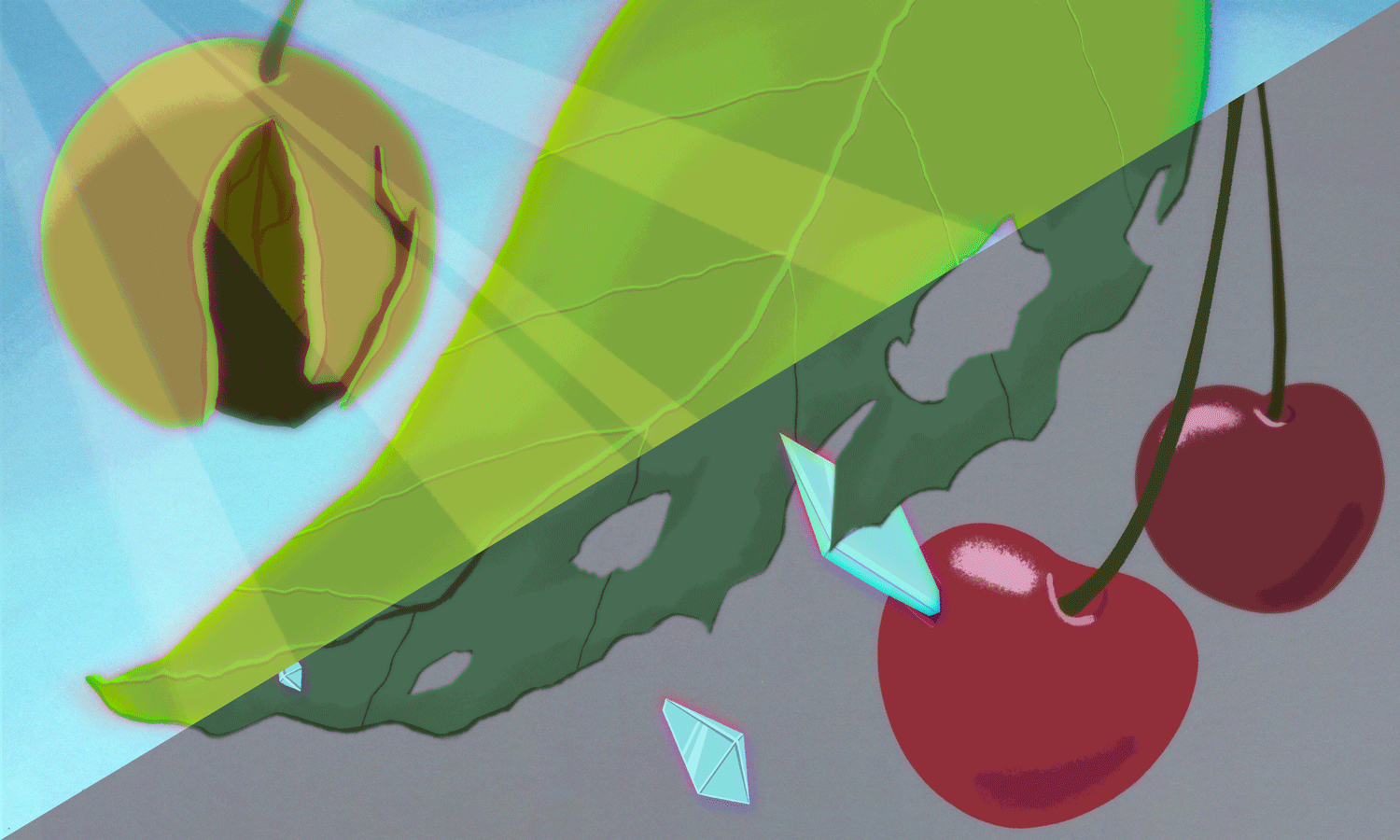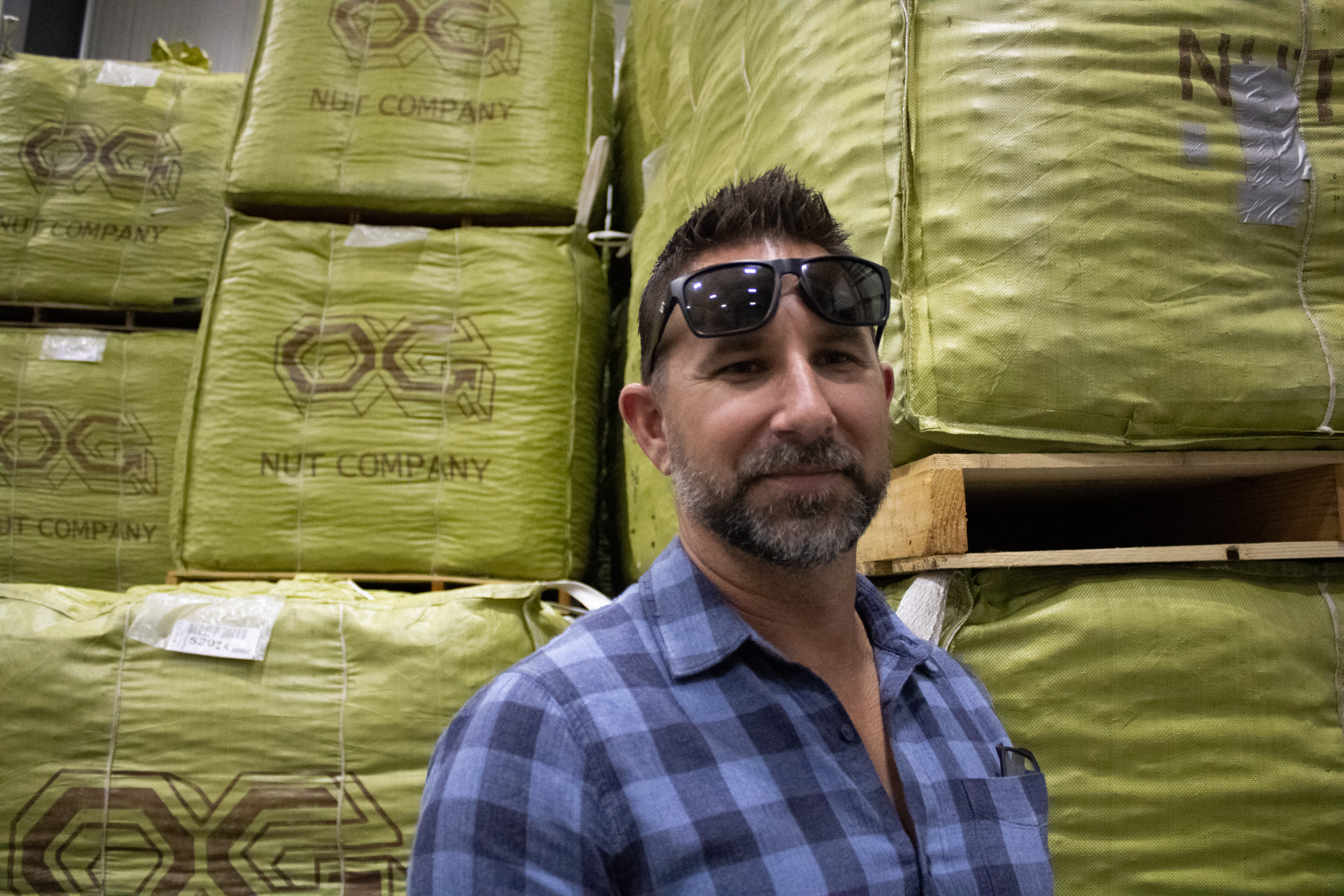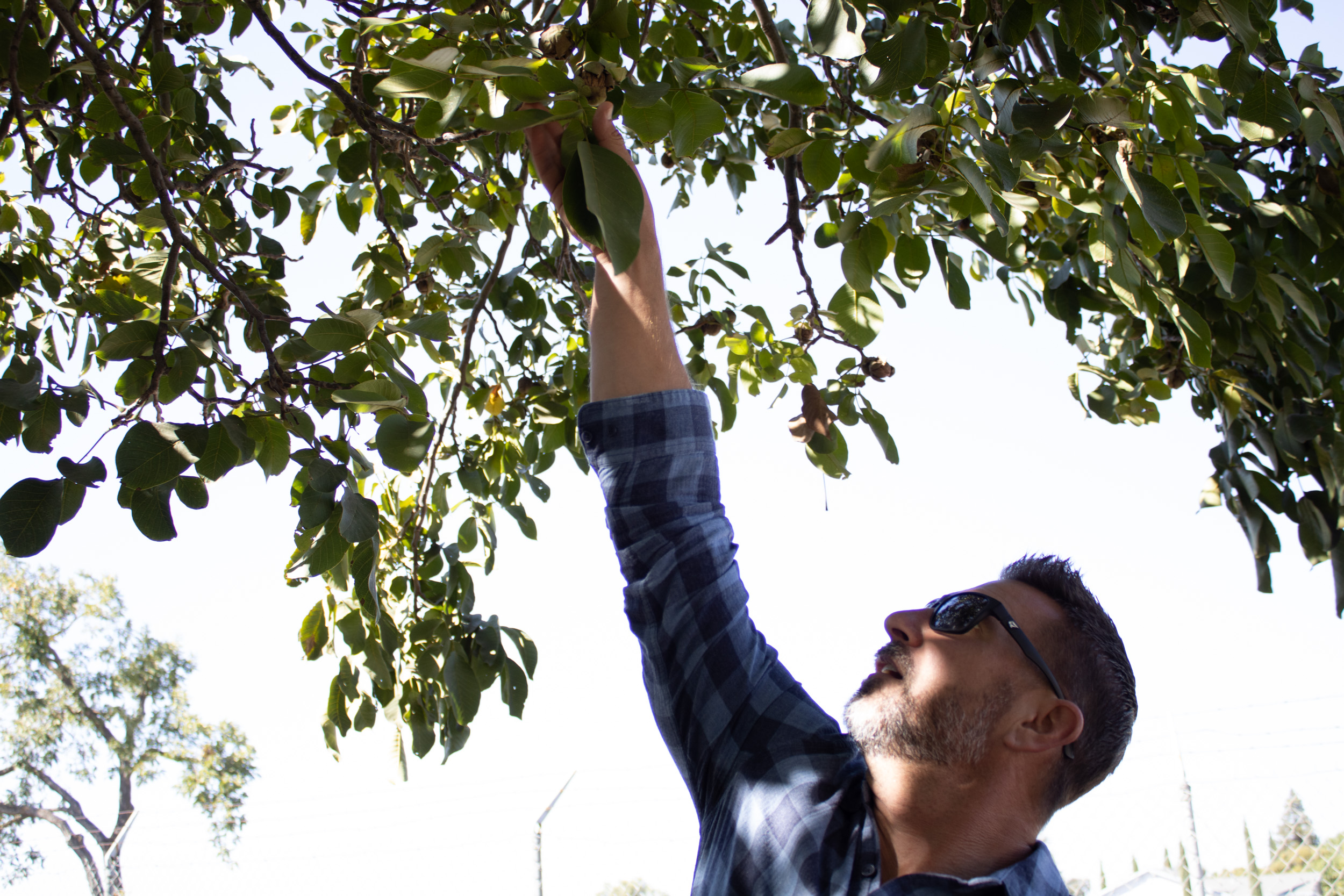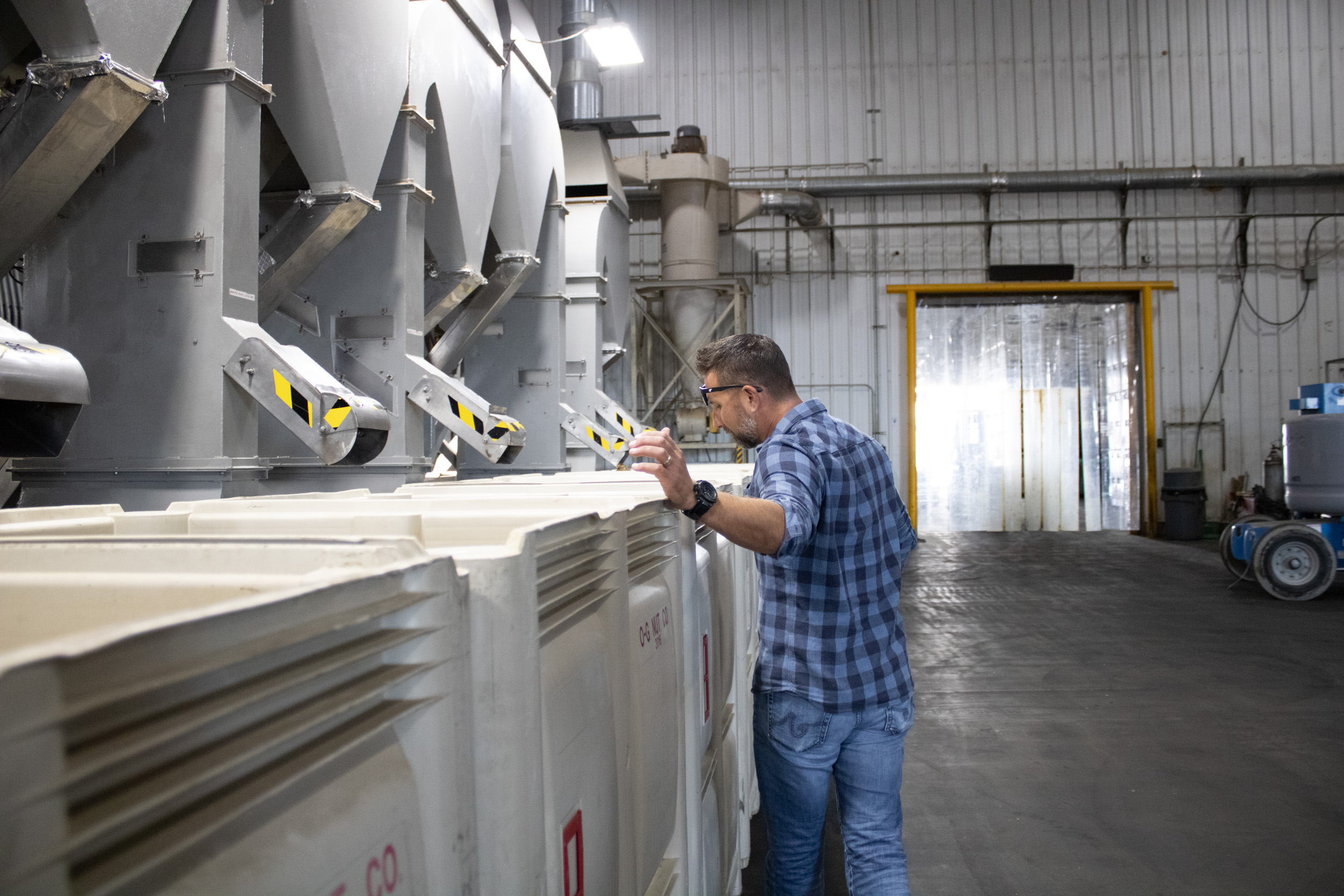
The
Impact
of
Climate Change
EEJOON CHOI / NEXTGENRADIO
Vivienne Aguilar speaks with Thomas Mangrich, a field representative for OG Packing and Cold Storage Company facility in Stockton, Calif. He advises cherry and walnut farmers around the state and guides them into their harvest seasons. In the last few years, extreme weather occurrences like record-breaking heat waves, downpours, and droughts have thrown off harvest seasons. Mangrich is the bearer of bad news when weather unexpectedly ruins a farmer’s yearly crop.
Gambling on the weather
Fried in the shell: Extreme temperatures
Click here for audio transcript
INTRO
Hello, I’m Vivienne Aguiliar with NPR’s NextGen Radio in Sacramento
Tom Mangrich calls himself a weatherman.
He’s made a career of helping California cherry and walnut farmers make the most of their crop.
But, over the last few years, climate change has made agriculture much more of a gamble…
… and Tom takes it personal when the farmers lose.
I start looking at the lifecycle of the cherry at bloom. the cherry buds start to swell up and…I start watching it at that point because weather is related at that point.
It can’t get too hot. That makes the fruit soft. So the weather directly impacts cherries
If a hail comes through, The hail will rip through the leaves. It’ll look like shotgun blast went through there, right through the leaves. The hail will rip through the leaves.
[Ambi]
My name is Thomas Mangrich. I go by Tom, and I work at OG Packing as a field representative for OG, and I work with the growers, and their commodities are cherries and walnuts.
The drought directly has an impact on the cherries, because most farms have wells, and they’re able to draw from the well. So the southern crops down from Bakersfield and Fresno area, a lot of these wells I’m talking about are starting to dry up because we just haven’t had the rain.
We need rain.
When we’re getting these extreme heat and I hear guys, old timers that I work with that are 80-90 years old saying they’ve never dealt with something like that Most people in this valley haven’t had to deal with the drought that we’re having.
[***Ambi] short
So they’re pulling their weight <*** up for 3-5 seconds> and then they’re unloading the walnuts into this pit
[sound of walnuts]
So in our department, we kind of joke that I’m the weatherman because of how closely I watch the weather and how much it directly affects the crops that we’re looking to harvest. So whether it be wind, rain, heat, drought, hail, all those things come in, come into play.
I have heard more often, let’s say in the last five years, guys talking about I don’t know if I can keep doing this, you know, more and more years after year, it’s okay, maybe next year, maybe next year, you know, and it just feels like especially weather related. I feel like every year there’s something new thrown at us and it’s, you know, like this year it was heat. But then couple of months before that, we’re talking about extreme freeze last year. And that downpouring rain we had in October directly affected the final chapter of walnuts for that year, because there were some fields that were unable to harvest because they just get stuck in the mud, they start molding and they’re unable to get into the field to harvest that product.
[ambi]
What we’re looking for is typically a light amber color, like a really light color. You can see this particular piece has been affected by the heat because it’s turned into like a combo or you can see it’s like starting to discolor and shrivel up and that’s basically a direct result from the heat that we had.
We see this every year, but we don’t see it as drastic every year. And we all know it came directly from that heat that we had.
[END SCENE]
I’ve had to tell guys to stop picking. They didn’t want to, but I had to. That’s really hard because you just, you’re basically going out and you’re explaining to a guy how if he continues to go, he’s going to lose money.
Sometimes you see fruit on the tree that looks perfectly okay and they want to harvest it. It’s in their blood. And you just have to tell them, unfortunately, there’s no value in that product. And I would advise you as a friend, you know, and, you know, a client, that you should stop.
We joke as a cherry grower you got to be a little crazy because, you know, you got to like to gamble because you’re definitely dealing with weather things that are out of your control.
So you almost have to trick yourself into being optimistic. And I think it’s it’s a joke, but I still feel it kind of hurts a little bit. But we always say, okay, there’s always next year.
On a dirt road off California Highway 88 a packing facility in Stockton preps millions of cherries and walnuts for families around the world. During harvest season, thousands of people rely on this factory for work — but that work has increasingly been impacted by climate change.
“I work for the growers because I like when they win,” said Thomas Mangrich, the field representative at OG Packing and Cold Storage Company.
Mangrich’s job is to watch the weather and make predictions for farmers who plan to send produce to OG’s packing facilities.
In October 2021, Stockton was flooded with almost five times the usual amount of rain it receives for the month, devastating walnut farmers.
“That downpour and rain we had in October directly affected the final chapter of walnuts for that year,” Mangrich said. Some walnut orchards in the area couldn’t be harvested because farmers simply couldn’t get through the mud and into their fields.

Tom Mangrich stands in front of packed sacks of walnuts that have been packed in October 2022.
VIVIENNE AGUILAR / NEXTGENRADIO
Walnut yields are projected to decline by 20% in the next two decades.
Mangrich takes it personally.
“I see these families, and I see them work hard and struggle,” he said.
This year, a historic heat wave hit the Central Valley and caused significant damage to walnut production. Since walnuts are oily, when temperatures hit 115 degrees the nuts essentially fried themselves, Mangrich said.

Tom Mangrich, a field representative for OG Packing and Cold Storage, holds out a walnut that cooked itself in its own oils during a historic heatwave that hit the California Central Valley in early September 2022. Mangrich said OG Packing and Cold Storage Facility sees this type of damage every season, but not as extreme as this year.
VIVIENNE AGUILAR / NEXTGENRADIO
“When we’re getting these extreme heats, and I hear guys, or old timers, that I work with that are 80, 90 years old saying they’ve never dealt with something like that,” he said.
Over the past 128 years in California, 2022 has been the driest year to date.
It’s affecting the trees and growth cycles of all kinds of fruits and nuts.
“Cherries are the ones that we usually worry about,” Mangrich said, “because walnuts aren’t perishable, like a cherry.”
It is normal for cherry trees to have good and bad harvest years because they get tired from producing. However, weather occurrences can throw off an entire orchard’s cycle. “In the coming years, the increase in variable precipitation — from drought to floods — puts our agricultural industry at great risk,” according to the California Climate and Agriculture Network. Throughout the year, he advises farmers on weather and industry demand to help them plan growing and packing when the harvest season comes around.

Thomas Mangrich, a field representative for OG Packing and Cold Storage Company, reaches for a walnut in an orchard in Stockton, Ca. As a field representative, Mangrich is responsible for alerting clients to potential weather occurrences that would affect walnut harvesting.
VIVIENNE AGUILAR / NEXTGENRADIO
Unfortunately, unprecedented weather can throw off an entire growing season.
“Whether it be wind, rain, heat, drought, hail, all those things come into play,” Mangrich said.
Weather is always variable. Farming is easily disrupted, but Mangrich has seen more extreme weather patterns in the past few years.
“It needs to be a certain temperature, you know, for a couple of months. It can’t get too hot, but it can’t get too cold. We don’t have the foggy winters that we used to have,” Mangrich said.
When cherries are damaged in developmental stages, he said it can cost the farmers, even if the fruit itself looks fine.
When it hails, balls of ice rip through cherry tree leaves like shotgun blasts, Mangrich said. Hail doesn’t have to pierce cherries to damage them enough to render them unsellable.

Walnuts are taken to OG Packing and Cold Storage Facility after being picked. The walnuts are then dropped into a pit with conveyor belts to be sorted, cracked or processed, depending on their grade.
VIVIENNE AGUILAR / NEXTGENRADIO

Tom Mangrich, a field representative for OG Packing and Cold Storage, looks into bins of unshelled and sorted walnut pieces. The machine separates walnut meat from their shells by using different levels of vibration.
VIVIENNE AGUILAR / NEXTGENRADIO
OG Packing uses a computer system to take pictures of each cherry, and it can detect bruising. Bruised cherries are deemed defective by the system and don’t do well on the market.
“[But the farmers still] want to harvest it,” he said.
“It’s in their blood … unfortunately, there’s no value in that product. And I would advise you as a friend and a client, that you should stop,” Magrich said. “It’s hard to watch them finally grasp that they’re going to be done.”
Farmers aren’t the only ones affected when weather occurrences disrupt a harvest season.
“You could set up for a full crop and you hire all these people that come help you and then a rain occurrence can come and wipe it all out,” Mangrich said.
The ripple effects that climate change has on the Central Valley’s cherry season could cost thousands of seasonal workers their jobs.
“Since I’ve worked here, we’ve done that one time where we basically shut the doors. We were done halfway through the season,” Mangrich said, “it rained and it just wiped out everything.”